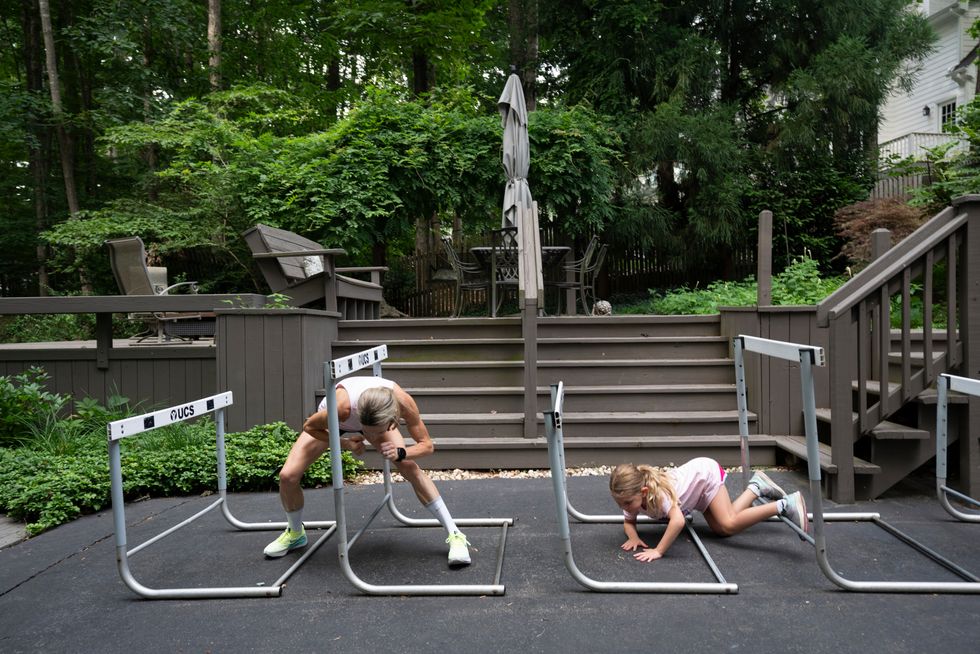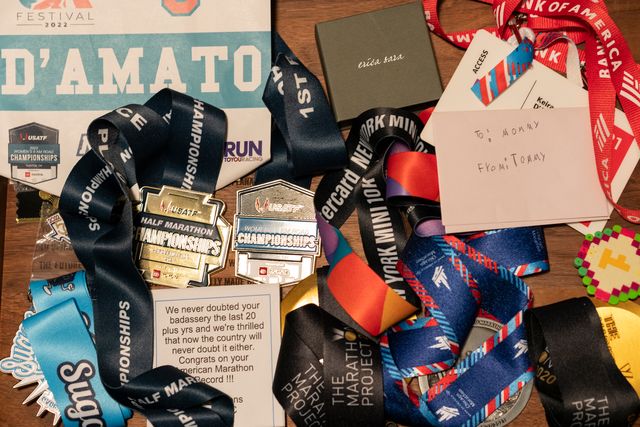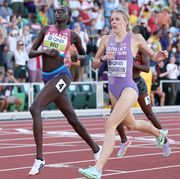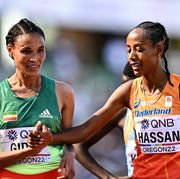It’s an early-spring Saturday afternoon in Midlothian, Virginia, and in a backyard buzzing with activity—kids on a zipline, flying baseballs, careening scooters—a race is afoot. The challenger: a freckled 7-year-old boy wearing the head-to-toe maroon of Virginia Tech. Accepting that challenge: a mom in black running tights, long blond hair pulled into a loose bun, smile incandescent. At the boy’s call, they scrabble down the wooden stairs of the back porch, dodge family members, and sprint up the driveway. There’s a few seconds of silence as the pair disappears around the front of the house, and then the boy rounds the corner again, yelling, “I beat Aunt Kiki running! I beat Aunt Kiki running!”
The loser pretends to breathe hard, hands on knees, and then protests teasingly, “Hey, I wasn’t running the tangents!” But Keira D’Amato doesn’t seem too disappointed. After all, just three months prior, at age 37, she set a new American record for the marathon in Houston, besting a time that had stood since 2006.
D’Amato’s success has been riveting to watch, in part because it seemed to come out of nowhere. She had only resumed running competitively in 2017 following a seven-year hiatus. In the interim, she adopted the life of a typical suburbanite—career, marriage, kids. And then, around the time most people are starting to reminisce about their glory days, D’Amato started living them. Really living them. She found more success in five short years than most elite runners do in an uninterrupted lifetime of training.
In 2019, D’Amato qualified for the Olympic Trials, and since 2020 she’s blown her All-American track PRs out of the water. She signed her first professional contract at age 36. She had planned to run the 10K at the upcoming World Athletics Championships, before getting a last-minute call-up to run the marathon instead. Qualifying for the 2024 Olympic Marathon in Paris is another goal. Her time from Houston, in January 2022, stands at 2:19:12, but she believes she can run a 2:18, the Olympic Team Trials qualifying standard for men.
You’d expect that in order to notch accomplishments and broadcast ambitions like these, you’d have to be impeccably organized. Exceptionally dedicated. And disciplined to the extreme—like any elite runner. Though D’Amato can be all these things, it’s sometimes hard to tell, because it’s clear to anyone watching her that she’s having the time of her life.
Several times a week, D’Amato makes the 15-minute drive to Pony Pasture, a verdant park along the James River, just a few minutes from downtown Richmond. She parks in the same spot and does the same stretches before taking off along the paved, tree-lined trail, doubling back to run the same stretch until she hits her mile marker. Between her full-time job as a Realtor in her mother’s Fairfax, Virginia, firm and second shift as mom to Tommy, 8, and Quin, 5, she only has time to fit in a single run a day, and she prefers to do it here.
It’s a prettier route than her neighborhood, but the more likely reason for its standing as D’Amato’s favorite is the people. Or, more specifically, the runners. Ever since she discovered running in high school on a whim (she’d signed up for track hoping to cross-train for soccer), she has loved the community that surrounds it, and even when sidelined by a foot injury, she never completely lost her ties with that community. Since Houston, she’s reveled in it.
Richmond has a lot of runners, but it isn’t known for elites, so D’Amato is their queen. It’s not unusual for those she passes (and she passes everyone) to toss out compliments, like the middle-aged man in a graphic T-shirt and baggy shorts who shouts, “Great job with all your running!” Keeping her reply as light and easy as her stride, she sunnily returns, “Thanks,” then deflects in a whisper, “That’s Ron. I paid him.”
She doesn’t come to be admired or adored; she just enjoys the camaraderie. After all, this is a woman who has been known to invite an entire field of participants in a local race to her house for chili afterward. And for D’Amato, jokes are as much a part of her training as foam-rolling (maybe even more so). While most Strava users title their runs with the date or location, she deploys puns: My husband and I had this long, pointless argument as to which vowel is the most important. I won.
It’s hard to say whether she does this for the benefit of her fans (she has more than 16,800 followers on the app) or for herself. Keeping the mood light is one way she has kept the pressure in check since her return to running. She likes to race her kids’ bus route in the morning to see if she can beat them to school. And when most races were canceled during the pandemic, she organized a run in Washington, D.C.’s Anacostia Park, got it officially certified, and named it the Up Dawg Ten Miler—a tribute to a bit from the sitcom The Office. (Her time? A 51:23, obliterating the all-women’s American record.)
Striking such a balance wasn’t always so easy. D’Amato started her career as intense as any elite. After bringing home six Virginia state crowns for her high school track team, she went on to become an 11-time Patriot League champ at American University. “All college Keira cared about was running,” she says.
Her single-mindedness sharpened to laser precision when she decided to try to go pro after college. She had enough promise and drive to join DC Elite, where celebrated miler Alan Webb was training under the tutelage of Scott Raczko. Her outlook quickly came into focus. D’Amato’s attempts to tell a few jokes fell flat. “I showed up a little bit goofy, but Alan was so meticulous, so prepared, so serious, and so successful,” she says. “To find my own success, I thought I had to be the same way.”
D’Amato became so obsessed with her times that she wrote her running goals on her bathroom mirror. “It really was eat, sleep, run,” she says. “I used to think it was inversely connected—working hard is not fun, so you can’t have fun working hard, right?”
The effort seemed to pay off. A couple of years into it, she’d lowered her PR in the mile to 4:33. But she was in constant pain, hobbled by a series of stress fractures caused by an abnormal bridging of bones in her foot. Surgery to repair it wasn’t covered by her insurance, so she gave up running in 2008. “I was forced out,” she says. “Not on my terms, but it felt like I quit.”
It stung, but not enough to permanently ding D’Amato’s natural optimism. Although she was able to get the foot surgery the following year, her competitive spirit had relaxed into a vibe more like that of an enthusiastic spectator. “I saw a lot of my running peers go on to have really great results, and I knew that wouldn’t have been beyond me,” she says. “But I also forgave myself, moved on, and filled my life with other things.”
One of those “things” was Anthony D’Amato, a charismatic and hilarious athlete she’d met in high school while attending Blue Ridge Running Camp. She and Anthony had remained close friends over the years, going to prom together and meeting for runs whenever Anthony was in town on break from the Air Force Academy. After finally realizing that they were in love, they quickly tied the knot on New Year’s Day 2012 in Las Vegas. That summer, when they celebrated the union with family in Virginia, the bride and groom (in wedding-themed running outfits) ran a 5K with more than 100 guests.
Running had become like the hold music in D’Amato’s life: not the point, but always present somehow. She would meet up with friends for a jog, or sign up for a local 5K here and there. Both of Tony’s parents were accomplished runners: His dad had finished the 800 fast enough to land in his high school’s Hall of Fame, and his mother founded her high school track team and has run a 3:25 marathon. And for a few years starting in 2011, D’Amato even took a job as director of marketing for a local running store, Potomac River Running.
In the seven-year span she calls her “elaborate halftime show,” D’Amato ran only a single marathon. After the 2013 bombing in Boston, she and Tony signed up for a race in Missoula, Montana, so they could qualify to run from Hopkinton to Boylston Street the following year. D’Amato had to walk much of the final six miles, stopping at every table that had gummy bears and stuffing them into her mouth. Her finishing time: 3:49:49.
She swore over and over she’d never do that again. Turns out, she was right.
Gravity felt like it was 20 times heavier than usual when D’Amato, a few months postpartum, stumbled out onto the streets of Midlothian in 2016. She lasted only half as long as the three minutes she’d envisioned. But she wasn’t discouraged. “I used to think that if I wasn’t going out for an eight-mile run, it wasn’t worth it,” she says. “But this time, even though I was coming back from zero physically, I still had all the knowledge of everything I’d experienced as a runner so far.”
Initially, that knowledge kept her from going too hard, too fast. She built up miles slowly, and this time around she measured her progress differently—not in terms of whether she hit a self-imposed goal or not, but how much fun she had attempting it. She readily acknowledges that this has been a way to temper her own expectations, even calling it her “fun shield.” “I hid behind ‘this is fun’ because it was safe,” she says.
But for a natural competitor like Keira D’Amato, the addictive feeling of running faster today than yesterday never completely goes away. “I never thought I could come back to being a professional runner,” she says. “I just made new goals, and the goals kept snowballing.” That Christmas, she prank-gifted Anthony with an entry for the 2017 Shamrock Marathon, and then felt guilty and decided to join him. On a raw March day in sleet, seven months after Quin was born, she couldn’t run slowly enough to stay with the 3:25 pace group—and finished in 3:14, 12 minutes behind her husband. “It was the last time I ever beat her in a race,” Tony says.
The fire was started: What could she do with more training? Better weather? She was curious, not yet driven. Then, during a workout in 2017, she ran a 5K repeat exactly as fast as her college PR: 16:09. “There I was, a mom, with a job, running for fun, and I just ran a 16:09 rep in practice by myself,” D’Amato says. “It sort of rocked my world.”
It opened her mind to the idea that her best running self might be in front of her. And, she says, “That’s when it became really fun. Now, the harder I’m willing to work, the faster I go, and the more fun I have. Setting the American record in the marathon,” she adds, “was one of the most fun things I’ve done in my life.”
On a 33-degree day in Houston in January 2022, D’Amato didn’t have history on her mind. “I wasn’t consciously trying to take down the American record, because I just couldn’t wrap my head around that,” she says. “All I thought about was a 5:18 pace.”
Still, her progress in the run-up to this day made it apparent that she was peaking for something big, something splashy. Just 23 days prior, on Christmas Eve, she ran an absolute banger: 22 miles with 10-mile and three-mile tempos, her average pace dancing around the low 5-teens. Her Strava followers knew it too, responding with strings of emojis.
Where many elite women are secretive about the details of their training regimens, D’Amato is refreshingly transparent, seeming to feel only props, not pressure. “Keira doesn’t care what other people think,” says fellow competitor and 2:25 marathoner Nell Rojas. “She’s not fearful of putting herself out there and going for things.”
Reentering the sport in her 30s required a mental overhaul as well as a physical one. Now D’Amato approaches the sport differently. She has a way of turning expectations into encouragement and, instead of worrying about failure, she runs with the joy of the moment. Photos and videos of her races, no matter the distance, no matter her finishing time or place, show her crossing the line with her arms raised, pumping, fingers spread into an ecstatic V. “I make my goals known, and if I fall short, I’ll still be in the same spot I am now. And that’s pretty great, too,” she says.
Though her approach is somewhat more laid-back than that of most elites, Keira also knows when to surround herself with a team that can be meticulous on her behalf. Houston was one of those races. “I’m not a big production athlete,” she says, “so I never want a big production. I just wanted two people I could trust.”
She went back to her former coach, Scott Raczko, who she knew would be her “secret weapon.” For pacers, she recruited Calum Neff, 37, a Canadian record holder in the 50K who had recently steered Sara Hall to a 2:20:32 in the Marathon Project. Neff’s extensive knowledge of the Houston course meant he could guide her through every pebble, every headwind, every tangent—enough to save her about one second per mile. “Looking at her workouts,” Neff says, “it was scary to think I was going to have to run with her. I know some high-caliber athletes who saw what she was doing and wondered, ‘Is this the right way to do it?’ But she was planning to run faster than anyone’s ever done it, so it’s going to be a little bit different.”
D’Amato’s other pacer was her longtime workout partner, Silas Frantz, 28, who had never before run 26.2. She found him in 2019 by scanning the results of local Richmond races, and his blistering 10K time caught her eye. Frantz was reliable, and also consistently one step faster than she was—just enough to take the mental burden of speed control from D’Amato and let her rip. He saw firsthand how quickly she could switch from good-natured trash talk to laser focus at the start of a workout, and then flip back to a happy-go-lucky running buddy when the stopwatch clicked off. “Keira always walks this weird fine line between being baffled by how good she is, and then also being confident that she can run the times that her workouts predict that she should be able to run,” says Frantz. “And she kind of just does it.”
It’s exactly what happened in Houston.
At 7:01 on race morning, the gun went off, and Neff and Frantz immediately began protecting her from all the other runners in the field. They found the first tangent. They were rolling. The first split: 5:18. The second: same. But for D’Amato, it wasn’t as effortless as she’d hoped—even though she had run tempo miles much faster. “I didn’t feel like I could lock in a cruise,” she says. “But you can’t go in expecting it to be perfect, because when it’s not, you get out of whack. I felt good, not great, and that was good enough.” Even after getting a blast of headwind at mile 10, the trio hit the halfway mark at 1:09:40, bang on.
Throughout the race, a truck rolled just in front of them, a big digital clock on the back scrolling through the pace of the previous mile, the time so far, and the projected finishing time. The group inched closer to the record, then hit record pace, then began to slow down. D’Amato started falling off the pacers, and almost asked them to ease up. “I went into this dark place, like, Why am I doing this? What is wrong with me?”
Up until then, Keira had been focusing on her pace, pushing away any conscious thought of breaking the record. But in that moment, she let a thought surface: “I told myself, I’m going to get the American record, either today or in another race. But if it’s not today, I’ll have to get to this point and work through it, so I might as well work through it right now.” She stopped looking at the clock, relying on Neff and Frantz to keep her on track.
As predicted, the winds were relentless until mile 18, and the two pacers blocked for D’Amato as best they could.
According to Neff, no one even told any jokes.
But then the gusts faded. Their pace picked up—around mile 20 or 21, they ran a 5:14.
With about 5K to go, Frantz bonked.
At 4K, D’Amato was right on Neff’s shoulder. When the wind gusted a final time, he put in one last block. “At 2K, she wanted to beat me, and I saw her fiercely competitive side kick in,” he says. “She started mowing guys down.”
D’Amato finally looked at her watch. “It’s really tough to do math when you’re so tired,” she says. “I was like, ‘What does 2:12 even mean? I think I can do this, but I still need to keep going.’” When she is in top shape, Tony calls her the Buzzsaw—as in, Don’t stand in the way, Keira is coming through. As she neared the tape, it was her mantra: Buzzsaw. Buzzsaw. Buzzsaw. And when she crossed the line, she lifted her hands into two L’s—for Love—her new variation on the V of victory. She put her hand over her face in a moment of incredulity. 2:19:12? Me? It was as if she still didn’t comprehend that 26 5:18’s in a row equaled the American record.
But before she could overthink it, her son ran up to her, and then her daughter. She embraced them. She checked her watch again. When someone handed her the flag, she held it out like a cape. Tommy looked up at her adoringly, still clutching a hand-drawn sign that read: Your 1# in my heart! For a moment, the victory was secondary. “He didn’t care whether I won or lost, and that’s just so freeing,” she says. “Running doesn’t matter to them. It allows me to take risks and shoot for the stars.”
For the past couple of months, D’Amato has been on a roll. She won the USATF 6K Championships in Canton, Ohio, on June 4, where she set a course record. On July 2, she announced that she’d gotten the last-minute call-up to race the marathon at the World Athletic Championships in Eugene, Oregon, on July 18. And on July 7, she and Anthony announced the midsummer opening of their new running store in Midlothian in partnership with Potomac River Running.
She is now irrevocably linked with running, but she attributes much of her success in the sport to her identity outside of it. “There’s a deep part of me that always wanted to have a family, and I’m just a solid person having this part of my life in place,” she says. During the crux years, when so many elite women agonize about when to start a family, D’Amato just went ahead and did it. She didn’t have to weigh her career, negotiate contracts, or worry whether her body would bounce back.
At the same time, she occasionally feels a little conflicted about the mom label. “My family is so much a part of my journey, but everyone keeps saying, ‘Can you believe a mom did that?’” she says. “I don’t see people calling out, like, ‘Oh, Galen Rupp the dad, he’s accomplished so much!”
When people say this about Keira D’Amato, though, it’s no exaggeration. She’s refused to give up work (although she did cut back on her hours in the run-up to Houston), and takes calls from clients on weekends after her runs, while slicing fruit for the kids’ snacks. She attends Tommy’s baseball games and Quin’s soccer practice and organizes family barbecues. And she is convinced that her recent race results, after that unfathomably long break, have come not in spite of these busy, bursting Saturdays but because of them.
“All of this”—the media attention, the awards—“is so flattering,” she says. “But the life I’ve built right here at home is more important to me. In the first part of my career, I was chasing success, and I wasn’t as happy. In this second phase, I’m chasing happiness, and I’ve found even more success.”
Having been forced once already to untangle herself from her sport and discover the Keira D’Amato who was not just a runner, she says, “I’ve learned how to forgive myself when I don’t hit my goals. I know what it is to fail, and it’s not that bad. Not every runner knows this, and for me, it’s powerful.”
So is the support of her family—she’s the oldest of five siblings—and Tony’s. When D’Amato started entering local races, Tony’s mom, Linda, would scream encouragement from the side of the road. And his dad, Tom, did track workouts with her until she got too fast for him.
And of course, there’s Tony, who has loved running since high school and knows just what his wife needs for support, whether it’s riding a bike beside her during tempos or taking care of the kids so she can enjoy the peace of a solo run. In preparation for Houston, Tony worked behind the scenes to make sure the whole family knew exactly where to spectate and when. “I had an official spreadsheet and I called it Operation Triple Windy,” he says. “I treated it like military ops. Keira knew what she was capable of, so we went all in.”
Her family’s support has also allowed her to remain independent. Not long after she wrapped 2020 with a personal-best 2:22:56 at the Marathon Project, finishing second to Sara Hall, Nike finally called with a sponsorship deal. But D’Amato wasn’t sure she wanted to go pro. Until then, her work in real estate funded her training, so she was beholden to no one, had no pressure to support her family through her sport, and felt no selfishness about running whatsoever.
“I felt really powerful that I was an unsponsored athlete doing it my own way, sticking it to the system, without being pigeonholed into one path,” she says. “When I chose a race, it wasn’t because it was a major. It was just, ‘Which race am I ready for?’ All I want to do is see how fast I can go.” Running was still the one way she found peace instead of pressure. Nike wanted her for exactly those reasons. She’s a runner we see ourselves in, even if she’s world-class. A down-to-earth unicorn.
So no, she’s not moving to Flagstaff to join an elite club. Most pros contort their lives around their training schedules, but D’Amato fits running around her life. “Everyone has unfinished business,” she says. “For almost eight years, I was just a recreational runner, and then all of a sudden, it seems, I set the American record. It’s an underdog story. People love an underdog.” (She eventually signed with Nike, announcing on February 9, 2021, on Twitter: “Everything and nothing has changed...”)
Back in Midlothian, D’Amato’s nephew suggests a rematch. For all her joking and lightheartedness and love of family, she doesn’t like to lose—and so she eagerly accepts. She bends down to make sure her neon sneakers are tied, and then checks her watch. As soon as she hears the word go, she’s positioned exactly where she wants to be: in the lead.
Evelyn Spence is a Seattle-based freelance writer whose work has appeared in Bicycling, Sunset, Backpacker, Ski, the Red Bulletin, and many others.





















